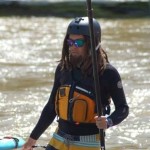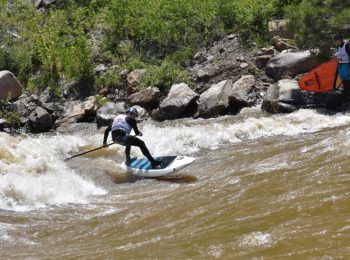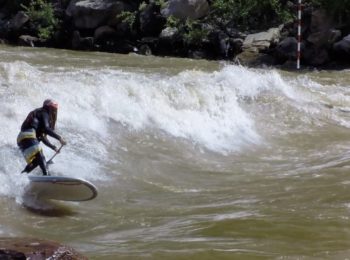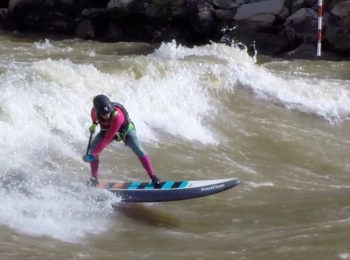Anna Fischer owns and operates Surf the San Juans with her husband Drew in Durango, Colorado. Surf the San Juans provides kayaking, snowboarding and SUP instruction to clients of all skill levels. They are one of the few outfits in the country that offers SUP river surfing specific lessons to their clients. I called Anna the other day to chat about SUP, owning a business, and teaching people to river surf.
How did you get started stand up paddling?
My husband, Drew, and I both come from a kayaking background. He started kayaking in college with the outdoor pursuits program. When he and I met, he got me into kayaking. I had just moved back from Hawaii where I was surfing a lot and working at an outdoor adventure kids’ surf camp. This was back in 2006 when I started kayaking. Then paddle boarding started to become popular and I got on one and absolutely fell in love. It kind of combined all my skills in kayaking and surfing. My knowledge of the river made the learning curve a little shorter for me. I think that’s true for a lot of kayakers who know how to interact with the current. Now I still love to kayak, but I’m having so much fun on the boards that I don’t do it as much as I’d like. 
Drew throwing down
What draws you to river surfing over ocean surfing or river kayaking?
As a kayaker you get to a point where you’re running really gnarly stuff and you’re literally risking your life. It’s all calculated risk, but I was getting to the point where I was pushing a little bit outside of the limits of what I wanted to be doing in the rivers. I found that by getting on a paddle board I could run class 2 and 3 whitewater without the consequences but it was still extra challenging. You can take the littlest, easiest riffles in the river and make it really exciting and challenging.
Do you find you adjust your board choice based on how difficult the river is?
Definitely. This winter I kept training and I was taking the Badfish 6’11” River Surfer down river through the whitewater park. I took all the fins off for an extra challenge. I tried not to break the board on rocks instead of paddling the big plastic boards we typically take like the Jackson SUPerCharger. 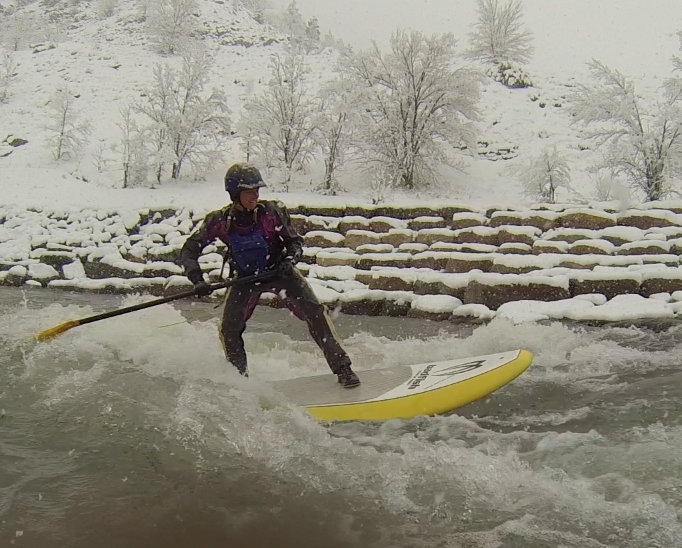
Anna surfing despite chilly conditions
Tell me about your first river surfing experience.
My first time ever river surfing was with Charlie MacArthur. He’s a pioneer of river surfing. He teaches all the ACA classes. Drew and I were both getting certified in 2013 with him. I was on a giant SUPerCharger and Charlie was telling me that I can’t surf on that board; I was too small and needed a different board. It was a little frustrating because the SUPerCharger was all we had as a startup company. So that’s what I learned on. Which I think in the long run it made me better at footwork because I had to throw around every bit of strength and weight I had to make it do what I wanted to.
Last year was my first time getting on a real board that could perform in waves, the Badfish 6’11” River Surfer. I got worked my first time out! It was embarrassing! I went out to Ponderosa Wave and literally three hours into my session I finally got on the wave. It was frustrating. I wish I had someone there to say “Hey, this is what you need to do to get in this wave.” I didn’t have anybody to go to, so I just had to keep doing it until I figured it out.
And now you are the person that people look to for river surfing instruction! Tell me about Surf the San Juans and how it got started.
Drew and I had been teaching whitewater kayaking and snowboarding for a long time. We both started teaching snowboarding in North Carolina before we came to Durango. I’ve been teaching swim lessons since I was 15 years old; so I’ve always loved being in the water and teaching the love of the water to people.
We finally decided to branch out on our own. We were trying to figure out what we were going to do with our lives and still have the lifestyle that we wanted. Which for us is traveling around and playing in different rivers. One summer we finally decided to go for it. We took a class at the college, we did homework and wrote a business plan. We dressed up, went to the bank and got a loan to purchase our equipment. We just went for it!
We’re going into season three now. We’ve learned so much. It’s still hard, but we’re doing it and having fun. 
Drew having too much fun teaching SUP
When you started Surf the San Juans were you doing SUP instruction?
Mainly kayaking at first because we didn’t have the knowledge for paddle boarding. That’s when we took a course with Charlie MacAuthur to really learn the differences between kayaking and paddle boarding. Even though there are so many similarities with the teaching progressions, it was cool to go under his wing.
To start with we didn’t have many surf lessons, maybe one or two. Last season I had 5 or 6. This year so far I’ve had 3 surf specific lessons, so it’s growing. It’s a niche market and I find that people who want to do these sports are very independently driven. A lot of times they aren’t going to pay someone to help them out, they just want to go for it. Which is totally understandable because that’s how I am as well. But there’s definitely a need for instruction.
If I was a person who came to you with zero SUP experience but a drive to learn how to SUP river surf, what would the first lessons look like?
We’d take you on the flat water to start with. The Animas river in Durango is really unique in a sense that the very top of the river, at the put-in area, is flat water. But there is still some current and some small, mild eddies. So that’s where we would start working on ferrying, footwork, edging and river safety. And of course we prepare students with everything they need as far as equipment.
From there I like to get people on a little stretch of whitewater. A small class 2 stretch just so they can get a feel for it. It’s really intimidating to take people straight to the whitewater park where they’ll get worked and never want to do it again. We try to break people in nice and slow.
What if someone had experience on paddle boards or kayaks, would you take them straight to the whitewater park?
Last year I had a girl would had lots of experience on lakes in Texas and she had her own board. I took her straight to the whitewater park at a really low flow. It really just depends, if people have kayaked before or are raft guides and have experience on rivers a lot of times we can take them straight into the park.
When we go to the whitewater park, we start in an eddy where it’s calm and work on footwork and maybe pivot turns. Then we’ll work on ferrying across the current. Often times we’ll start on the knees first and work up to the feet.
It depends on the individual. That’s kind of the basis of Surf the San Juans. We cater more to private instruction because everyone in river sports has a different drive. It’s such an easy thing (especially in whitewater kayaking) to get turned off. We think that an individual approach is usually the best. We don’t really offer traditional group lessons; we encourage people to do one-on-one.
What if someone came to you as a solid intermediate river surfer. They’re able to front surf and carve a little bit. What skills would you focus on?
Paddle strokes are awesome. I would probably go over that stuff because you don’t realize how much impact you can have on your surfing with simple strokes.
A lot of people progress to that intermediate level, but haven’t really learned some of the technical skills. Like staying in the paddler’s box and keeping their shoulders safe from injury. I’d probably do some flat water training on techniques like that and then get them into the wave. Low braces, high braces, switching hands quickly.
Anna ripping the Ponderosa Wave on her 6’11” River Surfer
You’ve talked a little bit about safety. Both river safety as well as injury prevention. What are some specific things you teach during your lessons?
People coming from a minimal whitewater background will always know the whitewater swim position: feet downstream, toes and nose in the air. I raft guided for a long time in the summers. That’s what we’d tell clients to do if they fell out of the raft.
It’s different when you’re out there trying to get in these features that people usually try to just break right through. We teach people that they’re supposed to get on their belly, swim back to their board and get to shore. Not just lay there and let the river take them downstream. Some of the misconceptions with the differences between recreationally floating down river in a raft and actually being on your own craft and trying to control where you’re going, are big things we emphasize.
We also teach the safety techniques with your body. How to avoid injury while paddling in easier circumstances. That’s why we usually start people on flat water if they’re wanting to learn to surf. That way they can get the good techniques down before they get into turbulent whitewater.
What advise would you give someone wanting to start a river surf SUP business?
Make sure you have the knowledge and background with river safety. A lot of companies are popping up and just jumping on the bandwagon. You also have to have a passion if you’re going to start a business. You have to have something that drives you to want to do it everyday. There’s no way we would still be doing this if we didn’t have that passion for what we’re teaching and the lifestyle that river surfing and running rivers offers. I would just recommend to make sure that it’s something you’re really into and can share that with other people.
What’s the dream river wave you want to surf?
There are so many! I would love to go to Skookumchuck to kayak and paddle board. I’ve yet to standup surf Glenwood which is epic and right up the road. And Idaho, I haven’t paddled there. There are so many places!
Thanks for the interview Anna! If anyone is interested in learning to SUP river surf, checkout Surf the San Juans.

